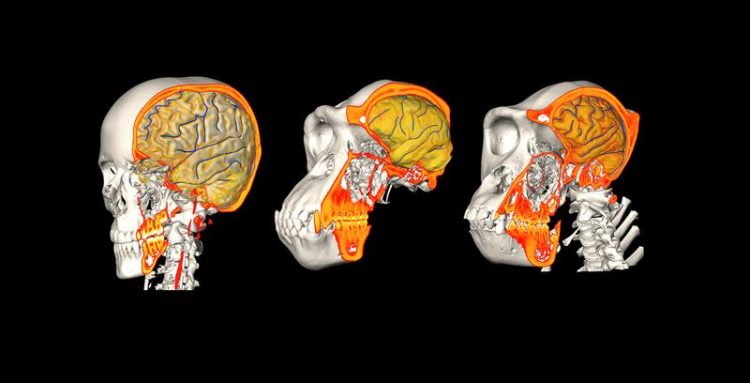The Brain Does not Follow the Head

CT/MRI datasets of a human (left), chimpanzee (center), and gorilla (right). J.L. Alatorre Warren, UZH
The human brain is like a fish in an aquarium, floating inside the liquid-filled braincase – but filling it out almost completely. The relationship between the brain and the braincase, and how they interacted during human evolution, has been occupying the minds of researchers for almost a century.
They addressed this question by studying brain-braincase relationships in our own species, and in our closest living relatives, the great apes.
Quantifying spatial relationships between brain and cranial structures
José Luis Alatorre Warren, researcher at the Department of Anthropology of the University of Zurich, tackled this question using computed tomography (CT) and magnetic resonance imaging (MRI) data from humans and chimpanzees. By combining CT/MRI data, he was able to quantify the spatial relationships between brain structures such as gyri (convolutions) and sulci (furrows) on the one hand, and cranial structures such as bony sutures on the other.
The results show that the characteristic spatial relationships between brain and bone structures in humans are clearly distinct to those in chimpanzees. While the brain and its case continued to evolve side by side, they did so along largely independent evolutionary paths.
Bipedalism leads to changes in braincase
For example, brain structures related to complex cognitive tasks such as language, social cognition and manual dexterity expanded significantly in the course of human evolution. This becomes visible as a shift of the neuroanatomical boundaries of the frontal lobe of the brain. This shift, however, did not affect the bony structures of the braincase.
Instead, changes in the braincase largely reflect adaptations to walking upright on two legs, or bipedalism. For example, the opening at the skull base for the spinal cord moved forward during human evolution in order to optimize balance of the head atop the vertebral column. However, these evolutionary changes to the braincase did not have an effect on our cerebral structures.
Point of reference for future research
“The brain followed its own evolutionary path of neural innovation while freely floating in the braincase,” summarizes Alatorre Warren. “The position and size of braincase bones thus don’t enable us to draw conclusions about evolutionary changes in the size or rearrangement of adjacent brain regions.”
Co-authors Marcia Ponce de León and Christoph Zollikofer believe their study’s data provide an important point of reference for future research: “Having answered the brain-braincase question for humans and great apes, we can now take a fresh look at the braincases of fossil hominids.”
Department of Anthropology
University of Zurich
Prof. Dr. Christoph Zollikofer
Phone: +41 44 635 54 27
zolli@aim.uzh.ch
Dr. José Luis Alatorre Warren
Phone: +41 79 196 75 90
luis.warren@aim.uzh.ch
José Luis Alatorre Warren, Marcia S. Ponce de León, William D. Hopkins, and Christoph P. E. Zollikofer. Evidence for independent brain and neurocranial reorganisation during hominin evolution. PNAS, 14 October 2019. DOI: 10.1073/pnas.1905071116
https://www.media.uzh.ch/en/Press-Releases/2019/Braincase.html
Media Contact
All latest news from the category: Life Sciences and Chemistry
Articles and reports from the Life Sciences and chemistry area deal with applied and basic research into modern biology, chemistry and human medicine.
Valuable information can be found on a range of life sciences fields including bacteriology, biochemistry, bionics, bioinformatics, biophysics, biotechnology, genetics, geobotany, human biology, marine biology, microbiology, molecular biology, cellular biology, zoology, bioinorganic chemistry, microchemistry and environmental chemistry.
Newest articles

Sea slugs inspire highly stretchable biomedical sensor
USC Viterbi School of Engineering researcher Hangbo Zhao presents findings on highly stretchable and customizable microneedles for application in fields including neuroscience, tissue engineering, and wearable bioelectronics. The revolution in…

Twisting and binding matter waves with photons in a cavity
Precisely measuring the energy states of individual atoms has been a historical challenge for physicists due to atomic recoil. When an atom interacts with a photon, the atom “recoils” in…

Nanotubes, nanoparticles, and antibodies detect tiny amounts of fentanyl
New sensor is six orders of magnitude more sensitive than the next best thing. A research team at Pitt led by Alexander Star, a chemistry professor in the Kenneth P. Dietrich…





















